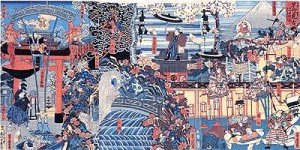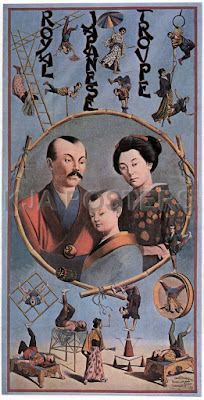 |
| Ukiyo-e print depicting 1864 first foreign circus visit to Japan. |
The title alone conjures up also sorts of delicious thoughts - like what does Andrew have planned for us today - something saucy, perhaps... but no... this blog is an informative look at Japan's history of the big-top. Yes... the circus.
I admit that in the three years I lived in Japan, I never came across a real circus. Plenty of festivals and lots of shenanigans usually involving myself and some silly young woman who wanted to try out the rides, but for me, more often than not, such endeavors usually revolved around me paying for a Freak Show.
But enough about my life as a barker, let's look back... way back to the 19th century, when people in North America or Europe may only have seen a real Japanese person as part of a circus.
No... the Japanese were no more freaky then than they are now - which is to say they aren't freaky now - but the country did have a closed door policy regarding the input and output of its natives... and well... Japan is quite a ways away.
So... when Japan's seclusion policy went up in smoke in 1868, the Japanese began to travel... actually they began traveling the world via the circus troupe.
 |
| 19th century Japanese contortionists. |
Perhaps it was due to the fact that in 1864 (four years before the fall of the Shogun and the seclusion policy), a circus troupe from the U.S.A. somehow managed to be allowed in to perform in Yokohama.
While gaijin (foreigner) still performed some trade with Japan, the vast majority of the country had never seen a foreigner before, and visited the circus with gusto. As well... seeing a woman ride a horse was quite the scene considering only warriors rode a horse (for the most part) - certainly not women.
Richard Risley, the leader of the foreign circus brought in a troupe of 10 artists and eight horses and performed bareback riding skills and other circus acts. While popular, it was really only limited to Yokohama. Still, Risley got a chance to see many of Japan's local acrobats, conjurers, contortionists, and more do their thing and was impressed with their skill, so much so that in 1866 he asked for permission and was granted it to take some performers with him to go on tour.
Billed in the US as The Japan Imperial Artistes' Company, it also visited Europe. Apparently this troupe was the first Japanese to gain permission with an extended overseas visa.
 |
| 19th century Japanese poster advertising a circus - Mt. Fuji in background. |
A popular attraction, several Japanese circus acts toured the world. World headlines were made after a female Japanese circus performer from one troupe had a child with a male Japanese performer from another troupe, giving birth for what the press happily determined was the first Japanese person ever to be born outside of Japan. That, of course, is open to argument.
But, perhaps more importantly, the first real foreign circus performers to enter Japan performed its first show on August 8, 1871 in Yokohama. The circus troupe was operated by Monsieur Soullier, 62, and he put on a spectacular show the likes of which Japan had never seen before. Later that year in December, the troupe obtained permission to perform at Tokyo's Yasakuni Shrine. It was here that the circus attracted many Japanese acrobatic performers and the like, including Torakichi Hayatake (surname first) who performed a grand feat of strength and balance, supporting a number of performers who were perched atop a pair of bamboo poles across his shoulders.
 |
| 20th century: Royal Japanese Troupe |
In 1887, an Italian circus led by a Mr. Chiarini were the first to bring wild beasts into the mix in Japan. By 1910, aeroplanes (archaic spelling of airplanes)were part of the show. This - 曲技 - is the Japanese kanji for acrobatic feats. If you copy and paste it as a Google search under images, you'll find photos of airplanes, lending credence that it might also have something to do with airplane acrobatics. Just a thought.
As for Japanese circuses before all of this, in the Edo jidai (Edo period) of 1600 - 1868, it was there. acrobats and jugglers et al. Maybe no animals, but it still existed to entertain the masses.
I believe that the foreign circuses were more popular than the Japanese-style circuses in Japan because of the novelty of seeing foreigners. And, vice versa, Japanese circuses were as popular abroad simple because many people had never seen a real Japanese person before.
 |
| 19th century Japanese fireman acrobats. |
Apparently lots of the special techniques used by the Japanese performers originated in China and India - two places were Buddhism was prevalent at one time - and was brought to Japan mostly by Buddhist priests and ascetics where it was honed and refined Japanese style - whatever that means.
Did you know that Harry Houdini, perhaps the most famous magician and escape artist ever picked up a fundamental skill from a member of a Japanese troupe - San Kich Akimoto - working in a foreign circus in the 1890`s. It was this learned skill that allowed Houdini to swallow something (a key) and then regurgitate it up at will. It's what made Houdini the master escape artist - able to remove himself from any manner of handcuffs or lock that bound him.
Japanese juggling also brought with it the Awata style, that was quite influential for many of Europe's greatest circus performers. When the first Japanese troupe came to the West in 1870, Katsunoshin Awata (surname first) showed off his skill at performing traditional Japanese ball and stick play from which modern ball manipulation evolved.
Here... take a look at an 1892 Ringling Brothers Route Book to see for yourself how many Japanese folk had joined up, like: Little San the contortionist, the top spinners Ando Hama Kichi, Miss Okee and her ladder of swords; Miss Oume who did a rope act: BIG TOP
It's too bad that the Japanese circus arts have diminished over the years turning more Euopean or American. However, traditional acrobatics in Japan can be found at the New Year`s Dezome-shiki firemen festivals (see below), and apparently at the Tsukumai festival in Ryugasaki, Ibaraki.
Files compiled by Andrew Joseph



No comments:
Post a Comment